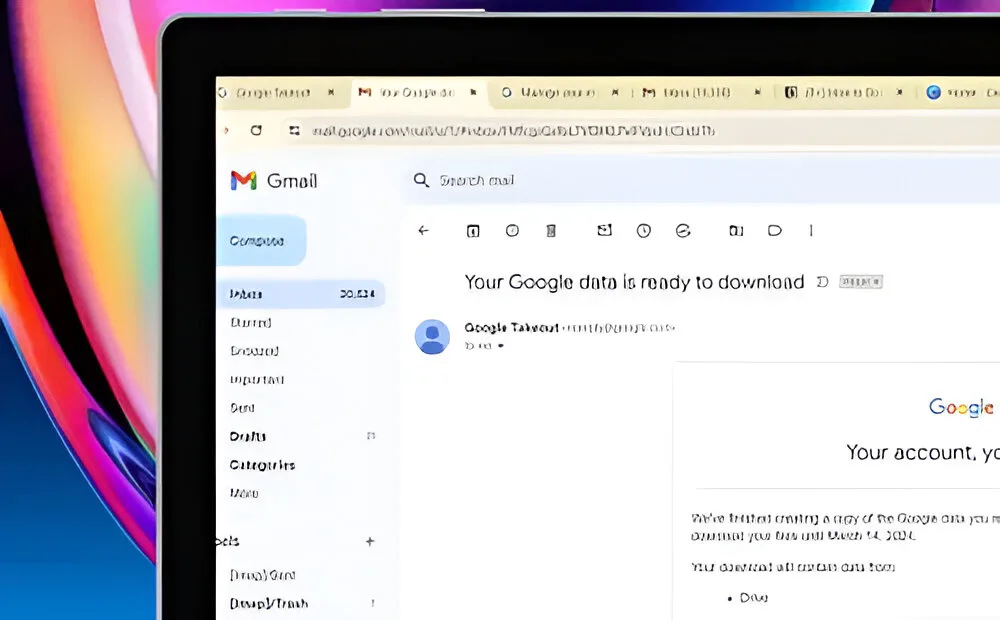
Let’s face it, we often find ourselves heavily reliant on Google and its services in our daily lives. Fortunately, all our Google account activities are securely backed up in the cloud, ensuring easy restoration if needed. This means there’s no need to worry about losing your data. You can also download your data as an extra precaution or before deleting your account, and this is where Google Takeout comes into play.
Google Takeout enables you to download all your Google account data, should you wish to delete a linked Google service or your entire account. Knowing how to use Google Takeout to download your data is essential in such scenarios. To guide you through this process smoothly, we’ve prepared a comprehensive guide.
How to Download Google Data Using Takeout on Your PC
While the process is generally straightforward, it can seem overwhelming due to the numerous settings and options displayed on your screen. To simplify things, we’ve broken it down into stages. Let’s go through it one step at a time.
1) Choosing Your Google Data
1. Sign In and Verification: Go to the Google Takeout web page, sign in with the Google account credentials you want to download the data for, and complete the two-step verification process if necessary.
2. Select Data to Include: Upon landing on the main Google Takeout page, click on “Deselect all” under the “Select data to include” panel. This clears all selections, allowing you to choose only the data you want to download.
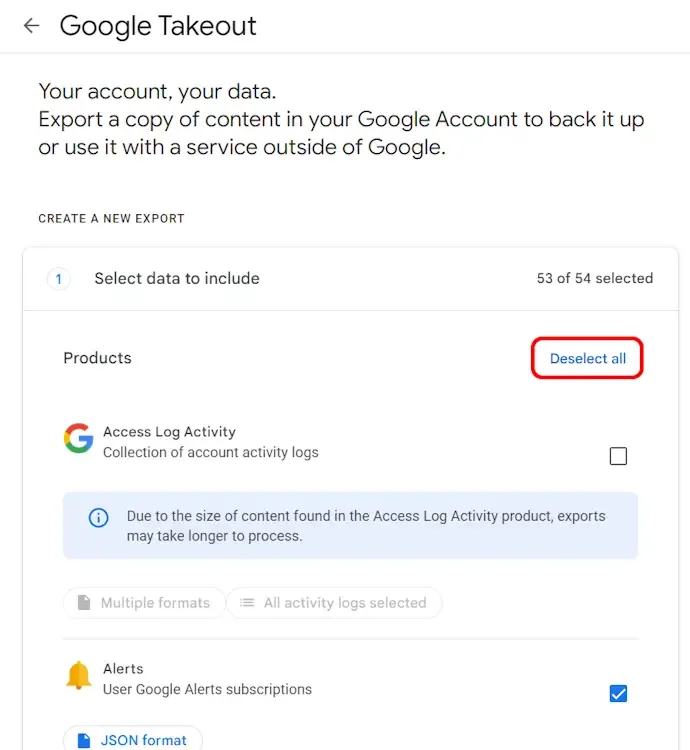
3. Choose Specific Services: Scroll through the list of Google services and select the checkboxes next to the services from which you want to download data. For simplicity, let’s focus on downloading Google Drive data for this example.
4. Additional Settings: After selecting Google Drive, additional settings will become available.
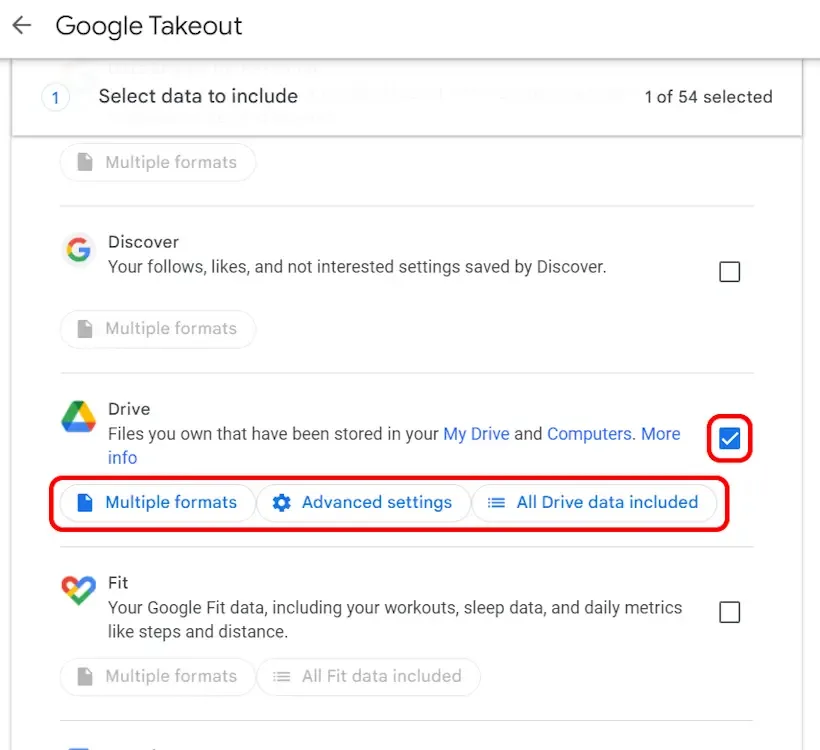
2) Specify File Formats for Your Google Data
1. Click on “Multiple formats” to open a pop-up window where you can choose the format for specific types of files in your Google Drive.
2. Use the drop-down menu next to each file type to select the desired format.
3. After making your selections, click “OK” in the pop-up window.
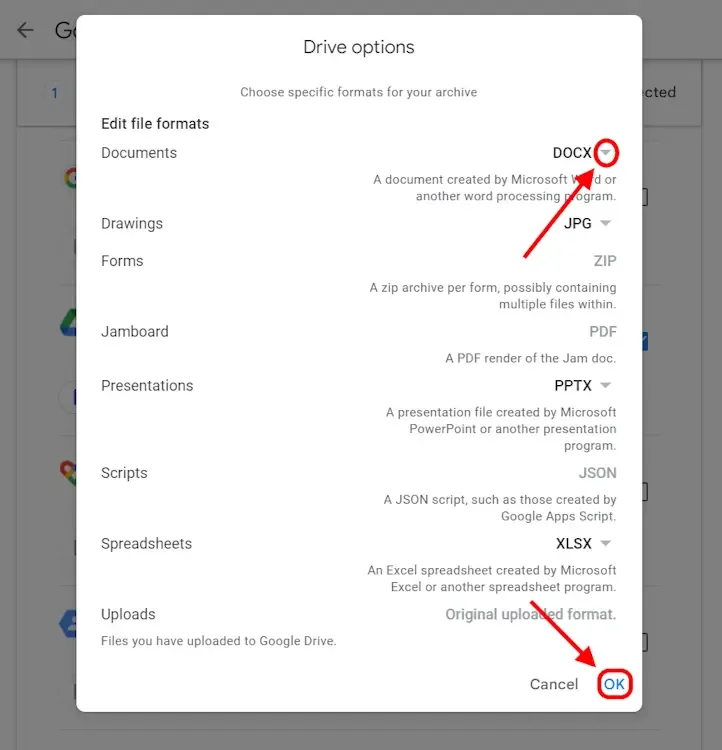
4. If you wish to, you can explore the “Advanced Settings” options, though they are not crucial. Click “OK” to confirm any changes.

5. To specify which Drive data to include, click on “All Drive data included.” You can then select or deselect specific files and folders by unchecking the “Include all files and folders in Drive” box and manually selecting the data you want to download. Click “OK” when finished.
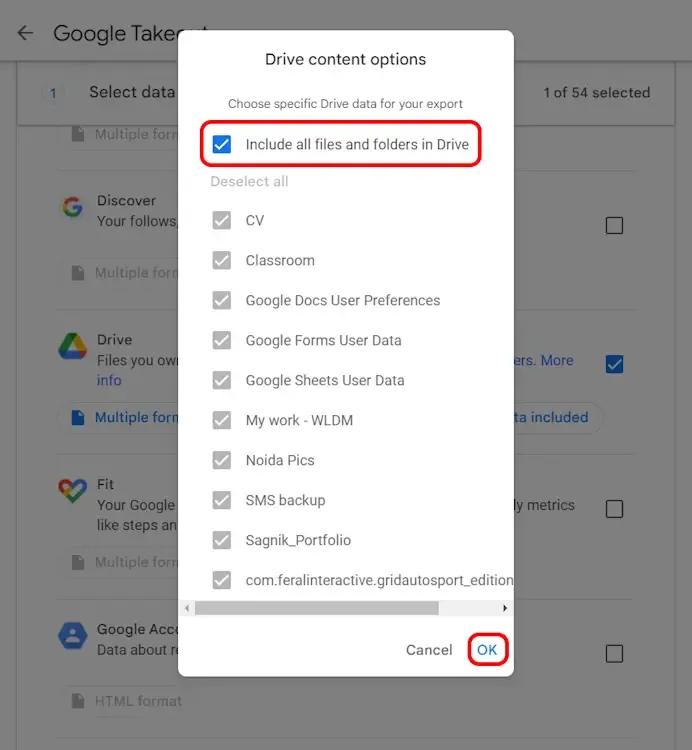
6. Once you have selected the data to download, scroll down to the bottom of the page and click on “Next step.”
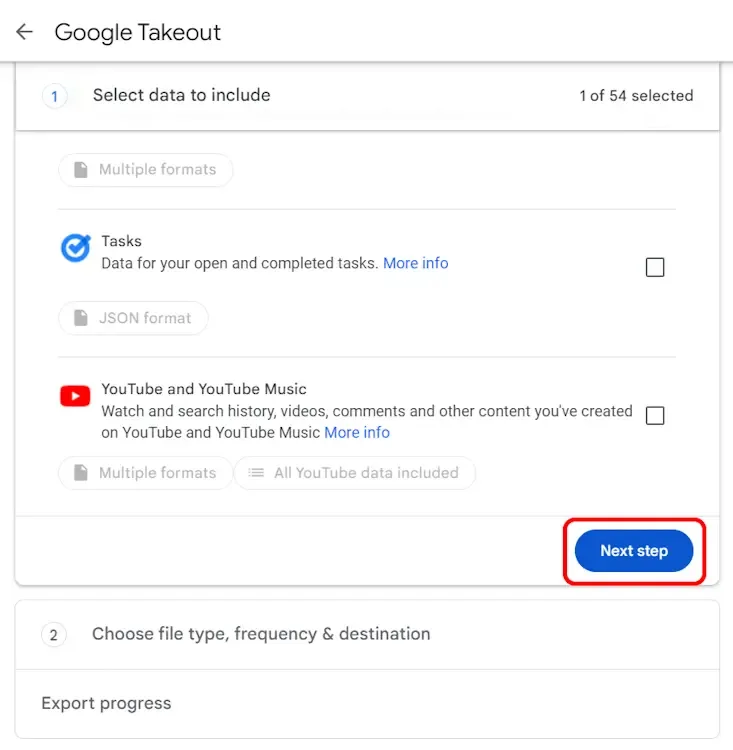
3) How to Select the Destination, Frequency, and File Type for Your Google Data
1. After clicking “Next step,” you’ll reach the “Choose file type, frequency & destination” panel.

2. Start by specifying the Destination for your Google data download. Tap on the “Transfer to” drop-down menu and choose “Send download link via email.” This option allows you to directly download files through a link, avoiding cluttering your Drive. This is particularly useful when dealing with potentially gigabytes of files.
3. Next, specify the Frequency of download. You have the option to select “Export once” to receive your files for immediate download or choose “Export every 2 months for 1 year” to receive 6 exports, one every 2 months for the next year. It’s recommended to make a manual export once every 6-8 months.
4. Moving on to selecting the File type & size, click on the “File type” drop-down menu and choose your desired file type. For downloading to a Windows system, select the .zip format; for a Linux system, choose .tgz.
5. Specify the File size from the drop-down menu, up to 50GB, depending on the compression level you prefer for your data. Note that files over 2GB will be compressed in the zip64 format, which may not be compatible with older systems.
6. Once you’ve set the File size, click “Create export” to initiate the download.
4) Managing and Downloading Your Google Data
1. Upon initiating the export, you’ll encounter the Export progress panel, which warns that the process can take a long time (possibly hours or days) to complete.
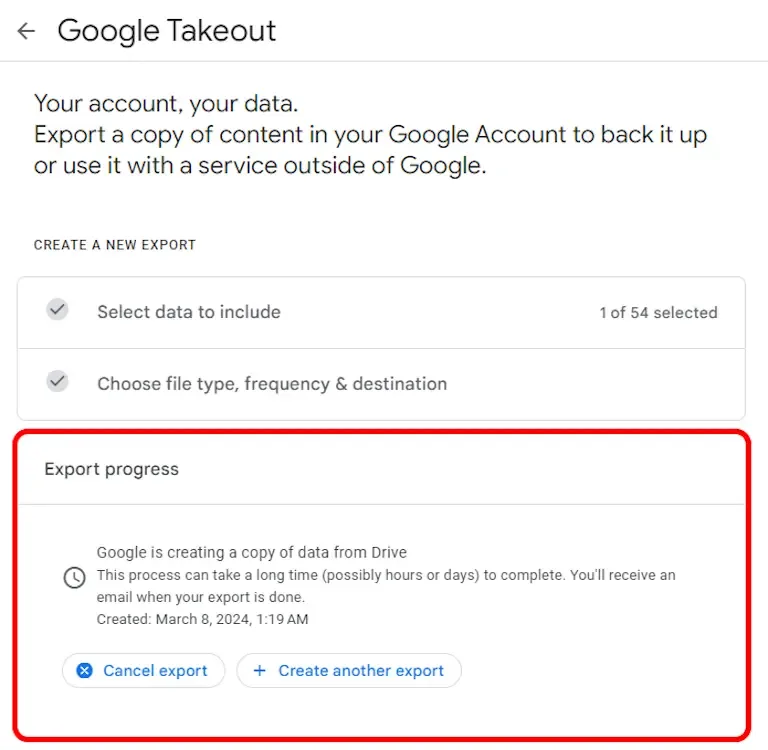
2. Check your inbox for an email similar to the one below:
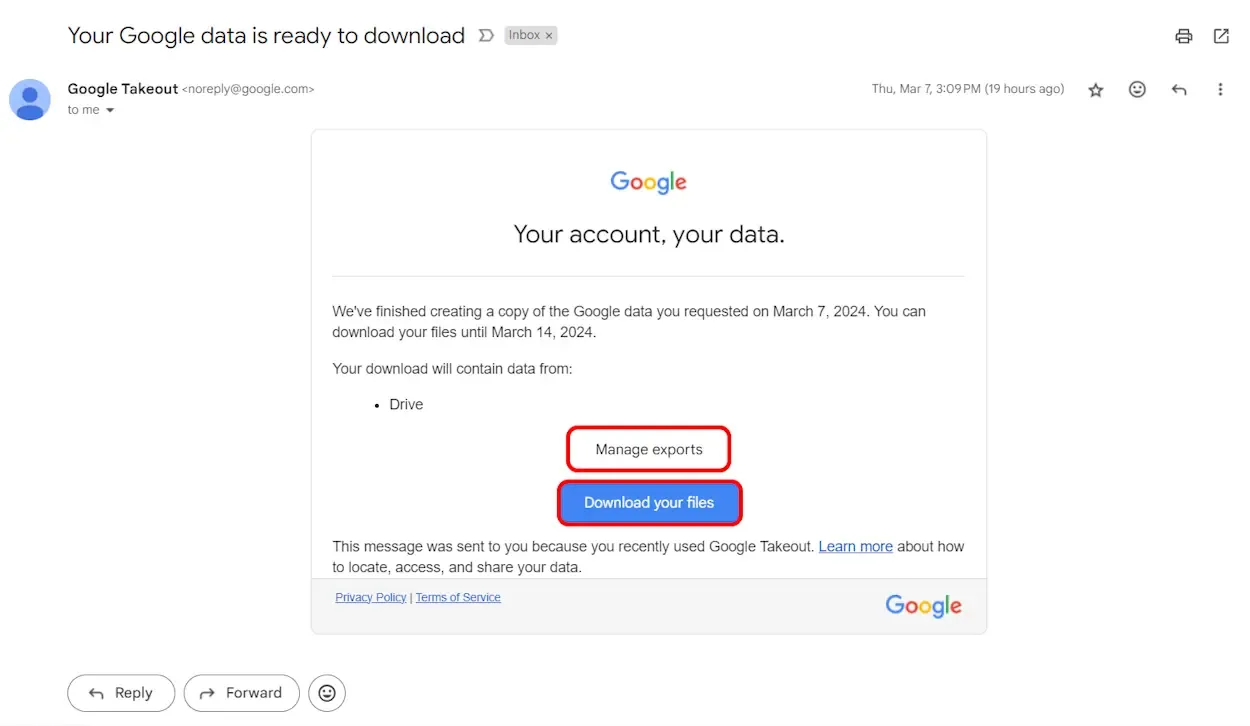
3. In the email, you’ll find dedicated buttons to Manage exports or Download your files.
4. Clicking on “Manage exports” redirects you to a page displaying the file size and the timeframe until the download link expires. After this timeframe, you’ll need to create another export since the previous link will no longer be valid. Keep this in mind. Meanwhile, selecting “Download your files” directly and instantly downloads the files to your computer.
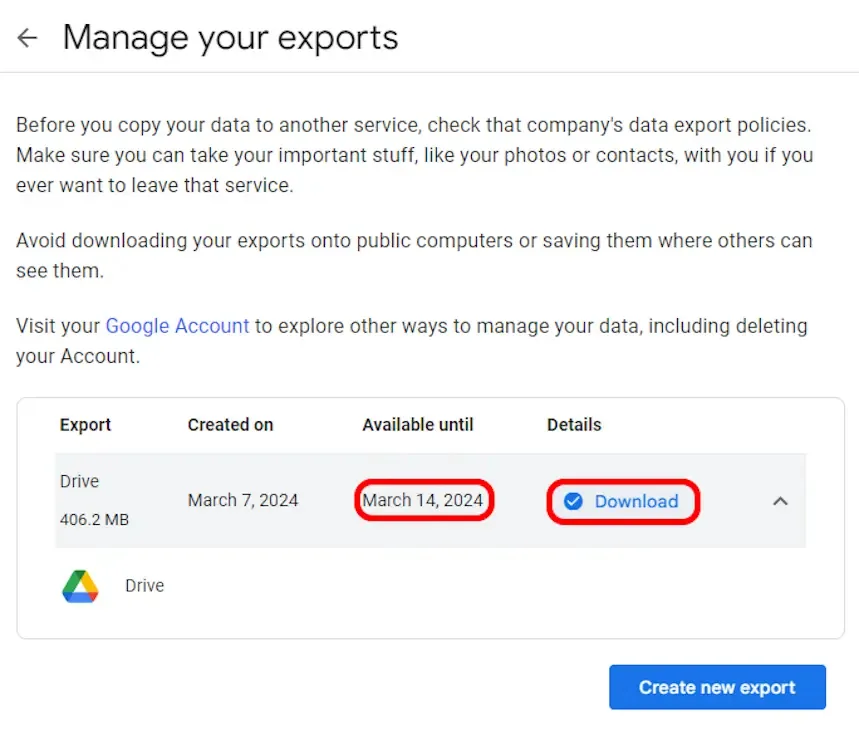
How to Download Google Data Using Takeout on Your Phone
1. To access Google Takeout on your mobile device, open the Google app on your Android or iOS device.
2. Tap on your profile icon at the top right corner and select “Google Account” (on Android) or “Manage your Google Account” (on iOS) below the Gmail address currently in use.
3. Swipe left until you reach the “Data & privacy” panel, then scroll down and tap on “Download your data.“
4. You’ll be redirected to the Google Takeout page in your default browser, where you can follow the same steps as on your PC.

5. After exporting your data from Google Takeout and preparing it for download on your PC or mobile device, the next time you visit the Takeout page, you’ll find your latest export at the top.
6. Below it, you’ll see dedicated buttons for “Show exports” and “Manage exports.” Clicking on “Show exports” displays a list of all your exports along with their sizes, each with a download button next to them. Selecting “Manage exports” takes you to the Export Management page.
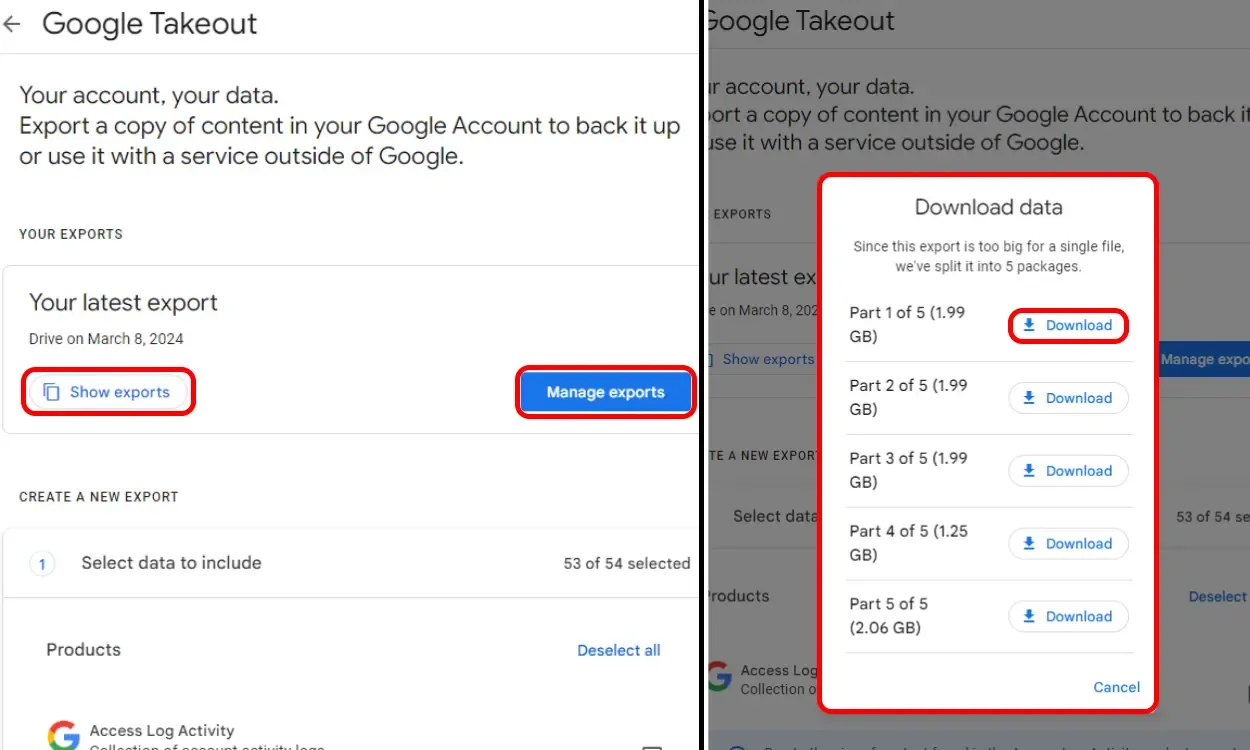
What Data Can You Download Using Google Takeout?
From the Google Takeout page, you can access a comprehensive list of all the data from Google Services that you can download. However, given the extensive nature of this list, here are some key services you might find most useful to download data from:
1. Google Chrome Data: This includes your browsing history, bookmarks, extensions, device information, and OS settings.
2. Android Device Data: This includes software versions, user settings, performance metrics, and account identifiers associated with your Android device.
3. Google Calendar Data: This includes your calendar events, appointments, and schedules stored in Google Calendar.
4. Google Classroom Data: This includes posts, submissions, and other relevant information related to your use of Google Classroom.
5. Contacts and their associated images stored in Google Contacts.
6. All likes and settings such as “Not interested in this” or “Not interested in a topic” settings.
7. Files and folders saved in Google Drive.
8. Data related to your Google One membership.
9. Sleep and activity data tracked on Google Fit, including steps, workouts, and other fitness information.
10. Your photos and videos stored and backed up in Google Photos.
11. Data from Google News, including your preferred sources of information.
12. Data from YouTube and YouTube Music, such as playlists, Watch and Search History, comments, and videos you have uploaded or liked on the platforms.
13. All your Google Voice data, including call history, messages, voicemails, and more.
14. Your Google Keep notes and any attachments associated with them.
15. Data from the Google Play Store, such as installed apps, app ratings, and more.
16. Google Pay data, including your transaction history and any payments or subscriptions made using the service.
17. Data from Google Play Movies & TV, including your watchlist and preferences.
18. Google Play Games data, such as achievements and scores.
19. Google Play Books data, including purchased books, uploaded titles, and more.
20. Records from your Google Developers profile.
21. Blogger posts, comments, settings, and your complete profile.
That concludes our guide on downloading your Google data using Takeout. We trust this guide has made the process easier for you. It’s a good practice to create Google Takeout exports regularly, and we recommend having a physical copy of your data as an extra precaution. You never know what might happen, so it’s wise to be prepared. If you encounter any issues, feel free to leave a comment, and we’ll do our best to assist you!




